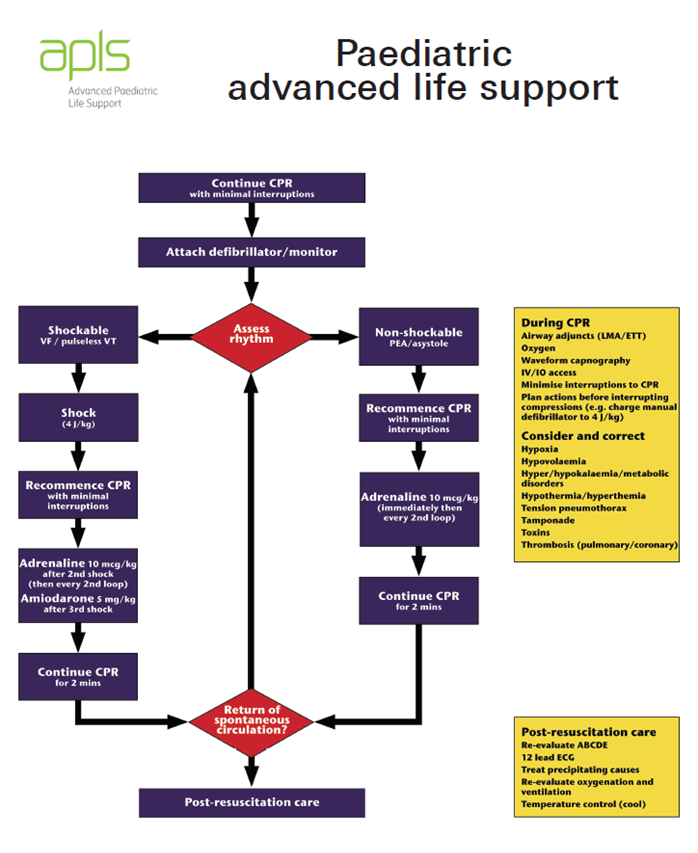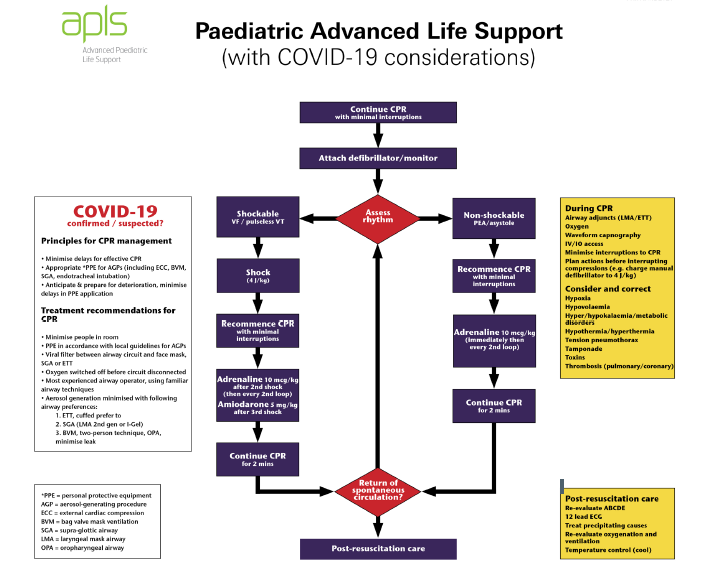Advanced paediatric life support
Disclaimer
These guidelines have been produced to guide clinical decision making for the medical, nursing and allied health staff of Perth Children’s Hospital. They are not strict protocols, and they do not replace the judgement of a senior clinician. Clinical common-sense should be applied at all times. These clinical guidelines should never be relied on as a substitute for proper assessment with respect to the particular circumstances of each case and the needs of each patient. Clinicians should also consider the local skill level available and their local area policies before following any guideline.
Read the full PCH Emergency Department disclaimer.
|
Aim
To guide Emergency Department (ED) staff in the assessment and management of cardiorespiratory arrest.
Key points
This guideline provides a refresher for the algorithms used in paediatric cardiorespiratory arrest. It is not a substitute for hands-on training courses such as the Advanced Paediatric Life Support (APLS) course.
General
Cardiorespiratory arrest in children is less common than in adults. For this reason, all health care providers who work in paediatrics should regularly review the
Advanced Paediatric Life Support algorithms to ensure their skills are up to date.
Assessment
- Ensure airway, breathing and circulation (ABC) issues are addressed as they are found.
- Pause chest compressions briefly to analyse the cardiac rhythm on application of defibrillator pads and every 2-minute cycle.
Management
- Perform continuous cardiopulmonary resusitation (CPR).
- Follow non-shockable or shockable algorithm.
- Minimise time off chest compressions.
- Insert intraosseous needle if no venous access available.
- Consider and address 4 H's and 4 T's:
- Hypoxia
- Hypovolemia
- Hypokalemia/Hyperkalemia/Metabolic Disorders
- Hypothermia/Hyperthermia
- Tension pneumothorax
- Tamponade - cardiac
- Toxins
- Thrombosis (pulmonary/coronary).
Refer to
- APLS Paediatric Advanced Life Support Algorithms
- APLS Paediatric Advanced Life Support Algorithms (with COVID-19 Considerations)
APLS Advanced Paediatric Life Support Algorithms

Access the full size PDF
APLS Advanced Paediatric Life Support Algorithms - with COVID-19 considerations

Access the full size PDF
Bibliography
- Advanced Paediatric Life Support (APLS) 2017 Book 5th Edition
- Australian Resuscitation Council https://resus.org.au/
- Textbook of Paediatric Emergency Medicine 3rd Edition Cameron P, Browne GJ, Mitra B, et al (2018) Publisher: Elsevier Edition updated
| Endorsed by: |
Nurse, Co-director, Surgical Services |
Date: |
April 2025 |
This document can be made available in alternative formats on request for a person with a disability.